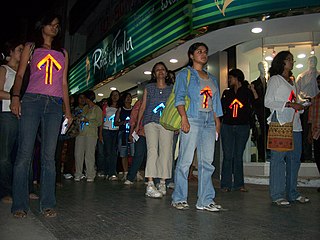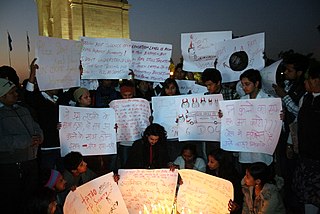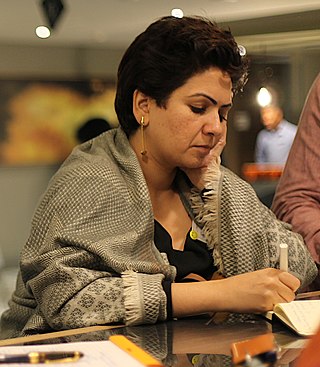
Capital punishment in India is a legal penalty for some crimes under the country's main substantive penal legislation, the Indian Penal Code, as well as other laws. Executions are carried out by hanging as the primary method of execution as given under Section 354(5) of the Criminal Code of Procedure, 1973 is "Hanging by the neck until dead", and is imposed only in the 'rarest of cases'.

The status of women in India has been subject to many changes over the time of recorded India's history. Their position in society deteriorated early in India's ancient period, especially in the Indo-Aryan speaking regions, and their subordination continued to be reified well into India's early modern period.

Blank Noise is a community/public art project that seeks to confront street harassment, commonly known as eve teasing, in India. The project, initiated by Jasmeen Patheja in August 2003, started out as a student project at Srishti School of Art Design and Technology in Bangalore and has since spread out to other cities in India.
Moral police is an umbrella category of vigilante groups which act to enforce a code of morality in India. Some of India's laws, and some actions of police forces in India are also considered to be instances of moral policing. The target of moral policing is any activity that vigilante groups, the government or police deem to be "immoral" and/or "against Indian culture".
The Mathura rape case was an incident of custodial rape in India on 26 March 1972, wherein Mathura, a young tribal girl, was allegedly raped by two policemen on the compound of Desaiganj Police Station in Gadchiroli district of Maharashtra. After the Supreme Court acquitted the accused, there was public outcry and protests, which eventually led to amendments in the Indian rape law via The Criminal Law Amendment Act 1983.
Crime in India has been recorded since the British Raj, with comprehensive statistics now compiled annually by the National Crime Records Bureau (NCRB), under the Ministry of Home Affairs (India).

The Uttar Pradesh Police, is the primary law enforcement agency within the Uttar Pradesh state of India. Established in 1863 as the Office of the Inspector General of Police, United Provinces under the Police Act, 1861. It is headed by Director General of Police (DGP).

In a sexual context, groping is the act of intentionally touching another person in a sexual manner, usually without their consent. The term generally has a negative connotation in many societies, and the activity may be considered sexual assault or otherwise unacceptable. Touching a consenting person's body during sexual activity, a massage, or a medical examination is not usually considered groping, though the term is sometimes used to include clumsy, selfish, or inappropriate sexual touching. Areas of the body most frequently groped include the buttocks, breasts, vulva, thigh, penis, and scrotum. Gropers might use their hands, but pressing any part of their body against another person can be considered groping.
Child sexual abuse laws in India have been enacted as part of the child protection policies of India. The Parliament of India passed the 'Protection of Children Against Sexual Offences Bill (POCSO), 2011' regarding child sexual abuse on 22 May 2012, making it an Act. A guideline was passed by the Ministry of Women and Child Development, India. The rules formulated by the government in accordance with the law had also been notified on the November 2012 and the law had become ready for implementation. There have been many calls for more stringent laws.
Rape is the fourth most common crime against women in India. According to the 2021 annual report of the National Crime Records Bureau (NCRB), 31,677 rape cases were registered across the country, or an average of 86 cases daily, a rise from 2020 with 28,046 cases, while in 2019, 32,033 cases were registered. Of the total 31,677 rape cases, 28,147 of the rapes were committed by persons known to the victim. The share of victims who were minors or below 18 – the legal age of consent – stood at 10%.

The 2012 Delhi gang rape and murder, commonly known as the Nirbhaya case, involved a rape and fatal assault that occurred on 16 December 2012 in Munirka, a neighbourhood in South Delhi. The incident took place when Jyoti Singh, a 22-year-old physiotherapy intern, was beaten, gang-raped, and tortured in a private bus in which she was travelling with her male friend, Avnindra Pratap Pandey. There were six others in the bus, including the driver, all of whom raped the woman and beat her friend. She was rushed to Safdarjung Hospital in Delhi for treatment and transferred to Singapore eleven days after the assault, where she succumbed to her injuries 2 days later. The incident generated widespread national and international coverage and was widely condemned, both in India and abroad. Subsequently, public protests against the state and central governments for failing to provide adequate security for women took place in New Delhi, where thousands of protesters clashed with security forces. Similar protests took place in major cities throughout the country. Since Indian law does not allow the press to publish a rape victim's name, the victim was widely known as Nirbhaya, meaning "fearless", and her struggle and death became a symbol of women's resistance to rape around the world.

The Criminal Law (Amendment) Act, 2013 is an Indian legislation passed by the Lok Sabha on 19 March 2013, and by the Rajya Sabha on 21 March 2013, which provides for amendment of Indian Penal Code, Indian Evidence Act, and Code of Criminal Procedure, 1973 on laws related to sexual offences. The Bill received Presidential assent on 2 April 2013 and was deemed to be effective from 3 February 2013. It was originally an Ordinance promulgated by the President of India, Pranab Mukherjee, on 3 February 2013, in light of the protests in the 2012 Delhi gang rape case.

The 2013 Mumbai gang rape, also known as the Shakti Mills gang rape, refers to the incident in which a 22-year-old photojournalist, who was interning with an English-language magazine in Mumbai, was gang-raped by five people including a juvenile. The incident occurred on 22 August 2013, when she had gone to the deserted Shakti Mills compound, near Mahalaxmi in South Mumbai, with a male colleague on an assignment. The accused had tied up the victim's colleague with belts and raped her. The accused took photos of the victim during the sexual assault, and threatened to release them to social networks if she reported the rape. Later, an eighteen-year-old call centre employee reported that she too had been gang-raped, on 31 July 2013 inside the mills complex.

Vishaka and Ors. v State of Rajasthan was a 1997 Indian Supreme Court case where various women's groups led by Naina Kapur and her organisation, Sakshi filed Public Interest Litigation (PIL) against the state of Rajasthan and the central Government of India to enforce the fundamental rights of working women under Articles 14, 19 and 21 of the Constitution of India. The petition was filed after Bhanwari Devi, a social worker in Rajasthan, was brutally gang raped for stopping a child marriage.
Violence against women in Tamil Nadu includes molestation, abduction, dowry-related violence, and domestic violence. The police recorded 1,130 cases during the first seven months in 2013, compared to 860 for the corresponding period in 2012. In Usilampatti Taluk, around 6,000 female children were killed in a span of 2 years during 1987–88, accounting to the single largest instance of recorded female infanticide.

Jasmeen Patheja is a human rights activist in India and was born in Kolkata, West Bengal. She graduated from Srishti School of Art Design and Technology in fine arts. She is a former Ashoka Fellow and works towards gender sensitization. She has been bringing attention to sexism and harassment in forms such as eve teasing, a form of sexual harassment which is very common in India. She established Blank Noise for the same purpose.
The dowry system in India refers to the durable goods, cash, and real or movable property that the bride's family gives to the groom, his parents and his relatives as a condition of the marriage. Dowry is called "दहेज" in Hindi and as جہیز in Urdu.

During the 2015–2016 celebrations of New Year's Eve in Germany, approximately 1,200 women were reported to have been sexually assaulted, especially in the city of Cologne. In many of the incidents, while these women were in public spaces, they were surrounded and assaulted by large groups of men who were identified by officials as Arab or North African men. The Federal Criminal Police Office confirmed in July 2016 that 1,200 women had been sexually assaulted on that night.
The Indian#MeToo movement began in late 2018 to manifest in areas of the Indian society including the government, the media, and the Bollywood film industry. In India, the Me Too movement is seen as either an independent outgrowth influenced by the international campaign against sexual harassment of women in the workplace, or an offshoot of the American "Me Too" social movement. Me Too began gaining prominence in India with the increasing popularity of the international movement, and later gathered sharp momentum in October 2018 in the entertainment industry of Bollywood, centered in Mumbai, when actress Tanushree Dutta accused Nana Patekar of sexual harassment. This led to many women in the news media, Indian films, and even within the government to speak out and bring allegations of sexual harassment against a number of perpetrators.
The Jasleen Kaur harassment controversy stemmed from the allegation of sexual harassment made by Jasleen Kaur against Sarvjeet Singh in 2015 and the events that followed. In August 2015, Jasleen Kaur, a woman from Delhi posted a photo of Sarvjeet Singh on Facebook, alleging that Singh had sexually harassed her. The post went viral on social media in India, garnering widespread attention. National celebrities and politicians provided Kaur with widespread support for raising her voice against eve-teasing and sexual harassment on social media.











